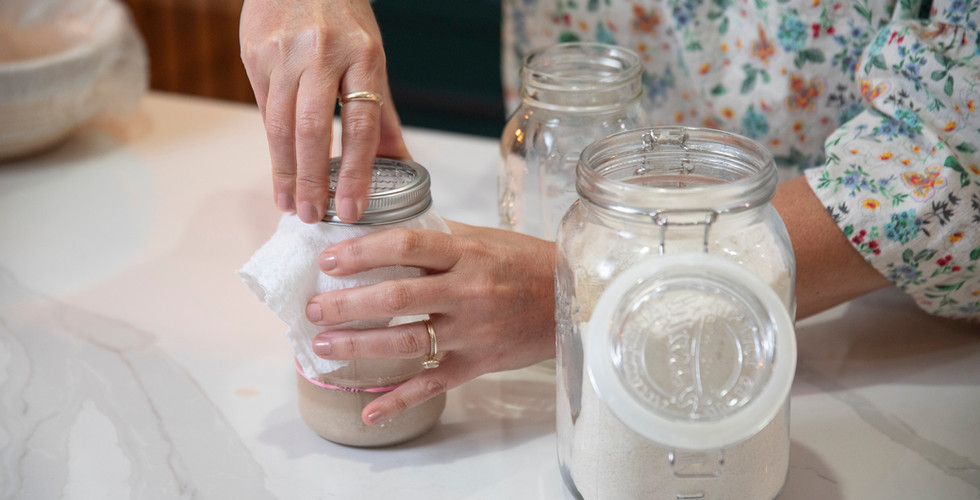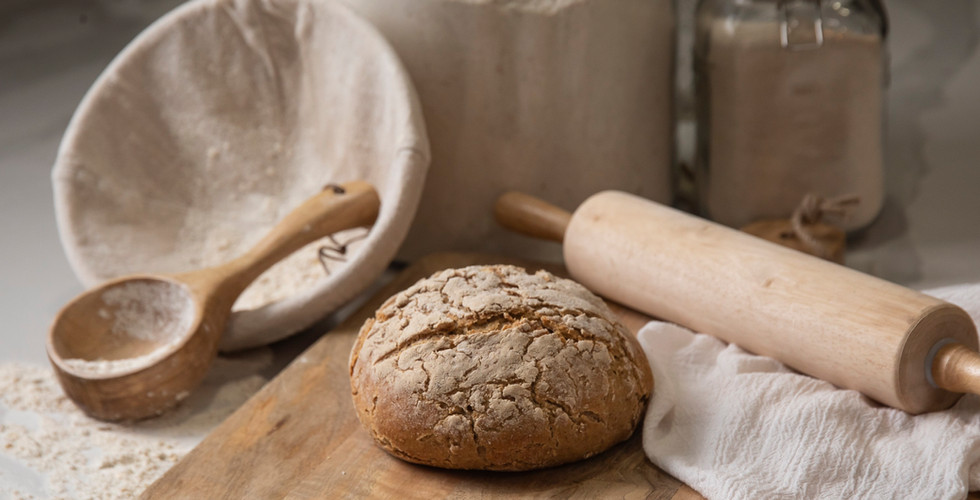Breaking Bread
- Invitation

- Nov 2
- 5 min read
Three local women find fulfillment in sharing freshly baked bread.

Written by Emily Welly | Photographed by Joe Worthem
A few years ago, Tupelo cake baker Tiffany Grice decided to attempt making bread. Meanwhile, in Oxford, Kelly Bell was in her home experimenting with a variety of flours to craft a gluten-free version of sourdough. And Melissa Hewitt had just purchased a flour mill for her Oxford kitchen so she could mill fresh wheat to bake for her family. They were each after different end results. But they all began experimenting with their chosen methods of baking so they could share freshly baked goodness with their families and their communities. And after journeys in the kitchen that included much trial and error, they have all succeeded in doing just that.
In the Business of Bread
Tiffany Grice has been baking since she was a young child experimenting with an Easy-Bake Oven.
She has been selling her baked goods for almost 15 years. For most of that time, she was known for her decorated cakes and cheesecakes. She has been a baker at Creative Cakes, Rosie’s and Strange Brew Coffeehouse. A few years ago, she began experimenting with baking a simple sourdough bread at home, and it was a huge hit among her customers. Brooks Grocery began carrying it to help meet the demand.
In fact, the success of her bread led her to open her own shop: One year ago, she opened Kreecher’s Creations, which in September moved to a new location at 1931 Mccullough Blvd. They sell all kinds of baked goods and breads as well as breakfast and lunch items. The shop is open 8 a.m.-5 p.m. Tuesday-Friday and 8 a.m.-2 p.m. Saturday, or until sold out.
“The number one thing I tell my staff is that my kitchen is a teaching kitchen,” Grice said. “We only learn by experimenting, and mistakes will be made, but that’s how we figure out what works and what doesn’t. I think that giving people creative freedom is when you bring out the true passion in them.”
Bread making presents its own challenges, but Grice has taken them head on.
“Bread baking is definitely not for the impatient,” Grice said. “Bread is a slow and time-consuming craft, but the final product is the best reward. My rule of thumb is that the bread works for me, I don’t work for the bread. I have adapted many methods to work for me and my schedule instead of the other way around.
“The key to baking a perfect loaf of bread is love,” she said. “You have to love what you do so that people can feel the love in what they eat.”
Sourdough Success (Hold the Gluten)
Kelly Bell’s journey with bread baking began in 2011 when her husband, Jeff, was diagnosed with Celiac disease.
“He’s the catalyst,” she said.
This was before gluten-free options became more readily available in grocery stores and restaurants. So, the Bell family began living a gluten-free lifestyle the best they could, and at some point, that led to experimenting with baking gluten-free bread. Specifically, sourdough.
“I’m from California, and I love San Francisco sourdough,” Bell said. “We were missing it. Jeff was missing it.”
Bell began experimenting with different recipes, tweaking them, tasting them, and trying again. The first challenge was to find the right type of gluten-free flour. “Gluten is just a binder,” she said. “Not all gluten-free flours are equal.”
A couple of years into her experimentation, she found near perfection in a sourdough starter made from brown rice flour coupled with a special yeast that allows the bread to rise. She admits what she’s making is not a purist’s version of sourdough bread. But that doesn’t bother her in the least.
“Finally, finally, I found one that actually works,” she said. “It looks and tastes and feels just like regular gluten sourdough.”
The sourdough starter is step one. Bell said to get the starter going, she begins by mixing brown rice flour and water in a glass container. Bacteria in the air begins reacting with the mixture, literally feeding on the water and sugar in the flour.
“Basically, you’re creating yeast,” Bell said. “It’s good, and it’s healthy and naturally antibiotic and antifungal.”
The starter is typically ready for use in baking in 3 to 4 days. And the bread recipe makes more than loaves of bread. Bell uses it for cinnamon rolls, pizza dough, biscuits and more. Bell has shared her starters with friends who can then use them to bake their own gluten-free goodies, and she has given plenty of bread to friends living gluten-free lifestyles. She also encourages them to give gluten-free baking a try themselves.
“Just be patient,” she said. “Just have fun with it. Don’t give up.”
The Whole Picture
“I’m not really a baker,” is the first thing Melissa Hewitt says when asked how she got started baking bread.
As a cancer survivor and mother of a pediatric cancer survivor, Hewitt was on a mission to find good nutrition when she discovered Sue Becker, an expert in making bread from freshly milled whole grains.
Hewitt began using Becker’s recipe (found at breadbeckers.com), and she was hooked.
“It was just incredible, the difference in how I felt and how I slept,” she said. “And that jump-started other nutritional habits, just by eating bread, which was delicious.”
The key ingredient is fresh milled flour, which first requires fresh wheat to be milled.
Hewitt — along with a growing number of others interested in baking with fresh grains — purchases her wheat in Water Valley or Abbeville where an 18-wheeler from Azure Standard does a prearranged wheat drop on a regular basis.
To mill the wheat, Hewitt first purchased an affordable used flour mill to get started. Then she began selling her bread to neighbors so she could save up to buy the bigger mill that she now has in her kitchen.
She keeps her freshly milled wheat in her freezer to prolong its shelf life, and she uses Becker’s basic recipe to make dough for her family’s sandwich bread, pancakes, toast, hamburger buns, dinner rolls, pizza crust, cinnamon rolls and more. And she said she doesn’t waste her “mistakes” — they get crumbled into breadcrumbs for use in other recipes like sausage balls.
She also sells some of her products, hoping to educate and interest others in the lifestyle. Her pancake mix can be purchased at Myer’s Apothecary and Grove Dental. She’s currently experimenting with a take-and-bake product that could be purchased frozen and baked at home. She doesn’t keep any secrets when it comes to how she bakes; her hope is to share the knowledge she has gained in her journey with whole grains.
“Even when I sell it to people, I’m selling with the hope they will make it themselves,” she said. “It’s a passion project more than a money maker.”
This type of baking is not just a hobby, it’s a lifestyle that requires a commitment to sourcing the proper ingredients and equipment, which can be tricky and expensive. However, there is now an entire community of people on the Oxford area, including Hewitt, who are educating others on the benefits of whole grain bread. One local group, Knead Your Cure, regularly holds tastings and demos and last year hosted a conference that included Sue Becker as well as other experts as guest speakers. Hewitt encourages anyone interested to reach out to them for guidance in getting started.
“Start where you can,” she said. “If you’re in Oxford, you can get to a person that has a mill and will be willing to sell the flour to you.”











































Comments